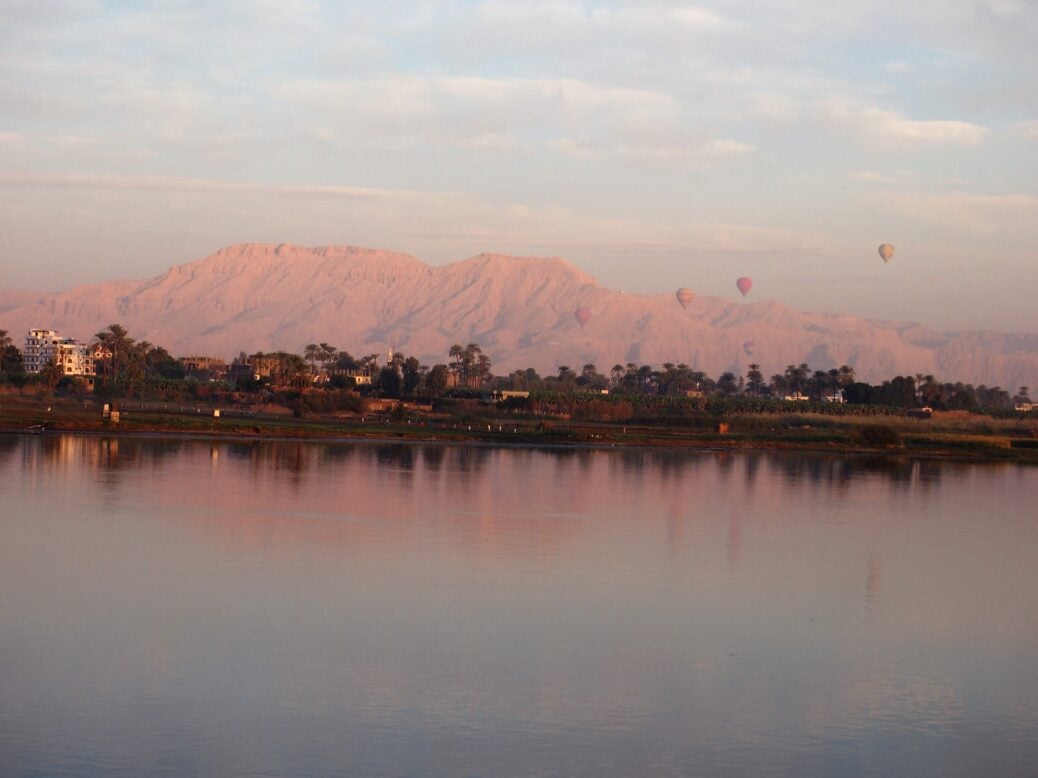
A luxurious cruise on the Oberoi Philae down the Nile brings an ancient civilisation back to life and reveals the breathtaking beauty of Egypt, writes Andrew Harris
Getting on board the Oberoi Philae Luxury Nile Cruiser creates just one problem. Once you’ve become accustomed to staggeringly perfect panoramas appearing around every bend in the river, and to the unassailable standards of luxury set by Oberoi (deftly applied by general manager Mahmoud Nourelden) — how will you ever entertain the notion of getting off again?
By the 1970s, the Nile was effectively owned by just two floating hotels, as they were called — the Hilton’s Isis and Osiris — with Upper Egypt clinging on to its role as an exclusive sleepy winter destination for moneyed Europeans and Americans. Direct flights into Luxor seemed a ludicrous notion, Hurghada on the Red Sea was busy doing what it always did — catching fish — and Sharm El Sheikh was a collective of tanks and Nissen huts idling underneath the Star of David. By the 1990s, however, a tidal wave of tourism had burst into the Nile Valley. Isis and Osiris were joined by the entire pantheon of gods: at its zenith, with a popular uprising erupting in 2010, there were almost 300 cruise boats. One revolution and several security breaches later, the figure is apparently down to 60, though it seemed more like 16.
Aswan, my point of embarkation, is the location of the first of six cataracts on the Nile, where huge lumps of rounded granite stand like giant geological doormen guarding the gateway to Sub-Saharan Africa. From the outside, the Oberoi Philae is relatively unremarkable, but at the other end of the gangplank, the stunning interior makes the prospects for serious indulgence here immediately apparent.
A recent overhaul has left Oberoi’s reputation for truly uncompromising opulence, forged in British India during the early part of the last century, very much intact. The decision to plunge headlong into the ultra-modern was a bold move, but the liberal use of leather, marble, mosaic, steel and glass has produced a minimalist masterpiece of light and space containing 22 capacious suites and rooms. The continually unfolding scenes of daily life on either bank, many of them unchanged for millennia, are constantly visible from huge picture windows.

The cornucopia of archaeological treasures that draws the entire planet to this small sliver of rift valley is, in and of itself, simply incredible. Even if you don’t have a clue what all those multi-headed snakes and bas-reliefs of half-people, half-animals are all about, it will hit you between the eyes regardless. But if you do happen to have a helping hand into this hypnotic netherworld — a dragoman to escort you into the intricacies of a universe so often dramatised — that will make an enormous difference. As always, Oberoi aspires to be the very best, and Baher, our onboard Egyptologist and part of the country’s large Coptic Christian community, is manifestly no exception.
A culturally resurgent Nubia, which looks south into Africa as much as the other way, has secured itself a Nubian Museum in Aswan, and it is there that Baher’s informative instruction into the incredible culture that prevailed here begins. The following day, after a visit to the Aswan High Dam — a focus of world attention in the 1960s when the painstaking relocation of many significant archaeological sites was required — Baher escorts us to our new home’s namesake, the Philae Temple, where the affinity for his métier becomes evident. Observe and you will begin to understand; ask and he will enthusiastically explain; engage a little further and he’ll have the Hittites jumping off the wall.
Lunch is served on the open deck of the boat, as we glide out of town, past Elephantine island and the Aga Khan’s mausoleum, which sits in sandy solitude on the edge of the desert. Perfect December sunshine glances off the calm waters, the big blue sky becoming bigger and bluer until the last vestiges of the first cataract are finally expunged. Arabic coffee is served, as a distant camel train on the west bank trudges through the desert, and a passenger train to the east veers so close to the river that it looks like it’s running through it. The loud slap of fishermen’s oars hitting the water to drive fish into their nets, against a huge red sun gently slipping into the Sahara, almost jolts me back to the real world — almost.
The next few days cocooned inside our floating fortress as we head towards Luxor assume an almost trance-like hedonistic simplicity. It’s as if all life, in order to be lived to its full potential, needs to be conducted on board a sumptuously appointed large boat, interspersed with gourmet distractions and lectures on ancient history. All around us is overwhelming politeness, courtesy, quiet efficiency, and attention to detail. The drama and the noise seem to happen elsewhere. That is probably not an accident. That is probably Oberoi.
At Kom Ombo, the big bend on the river that is home to Sobek the crocodile god, we trawl the remains of his temple and gawp at magnificent mummified crocodiles, which gaze idly back, perfectly preserved, as if they’d been placed there just last week. Crocodiles, which used to be prevalent all along the river, were hunted to extinction here, though there are still plenty on the other side of the Aswan Dam. In Edfu, we stand riveted by the power and presence of one of the best-preserved temples in Egypt — that of Horus, the falcon-headed god — before Baher winds us down deeper into the hidden world behind the hieroglyphs. Eventually, the journey’s end comes into view — we get our first distant glimpses of the extraordinary open-air archaeological lecture theatre that is Luxor.
Emphasising just how ancient Ancient Egypt is, we discover that the first tourists to come to Luxor and marvel at the gigantic statues and temples were actually Ancient Greeks: eventually adapting their own culture into the hybrid Ptolemaic period, of which Cleopatra was part. From the Ptolemies to the invading Arabs in the 7th century (who gave the place its modern name, after the buildings they discovered half-buried in sand and which they called ‘Al Uqsur’ — ‘the palaces’) to the latest invasion of Chinese selfie sticks, the allure doesn’t dissipate, and surely never will.
Luxor today has relinquished its slow, small-town atmosphere, having been barged aside by a rapacious tourist industry infrastructure. A ‘bazaar’ appeared, which is merely a strategically positioned purveyor of King Tut tat and sphinx ashtrays to the passengers of 300 boats who have temporarily abandoned ship. But for all the concerns about security, and tourist industry overload, Luxor and its environs remain as spellbinding as ever — and at this present moment, uncharacteristically accessible.
The journey, best begun at dawn, to the west bank of the river — the City of the Dead, where the sun god Ra disappeared every day in his chariot — is a day out like no other. Calmer than the east bank — where the main town, as in ancient times, is located — the crisp, bone-dry atmosphere of this sun-showered ancient necropolis is a lot more than just Tutankhamun’s tomb. The boy king’s world-famous discovery in 1922 (by Howard Carter, whose house we pass along the way), while undeniably wonderful to visit, is only one part of a huge archaeological jigsaw painstakingly pieced together by Egyptologists over centuries, of which the Valley of the Kings remains the most popular piece.
Unlike Tutankhamun’s resting place, many of the tombs are huge. With their astonishingly well-preserved, vibrant colours portraying the stories and symbols of an exotic and mysterious culture, they remain truly mesmerising experiences for anyone fortunate enough to find themselves inside.

The systemic shock of a visit to these wonders across the water can take a while to recover from. Dinner on the upper deck of the Oberoi Philae helps to this end, with a full moon dancing in the river. This is followed by a night-time saunter through the illuminated columns of Luxor Temple. Visible from every angle, right on the river’s edge, this edifice stands as an ever-present, beautiful and defiant riposte to whatever touristic excesses happen to unfold around it. A recently excavated avenue of sphinxes, revealing an ancient conduit from Luxor Temple to the larger Karnak Temple a few miles away, also makes for a perfect stroll after supper.
Karnak is actually a huge collection of temples, continually added to by successive pharaohs, mostly during the New Kingdom period — which, in Egyptian terms, is relatively recent, falling a mere 3,500 years ago. As the largest ancient religious site in the world, second only to Angkor Wat in Cambodia, it very much plays in the premier league of tourist attractions.
The story of Karnak is the story of Thebes, as the Greeks named Luxor — which in turn is the story of Ancient Egypt. The sheer scale and scope of its hypostyle hall is captivating, with its 134 majestic columns — it’s instantly recognisable from television and film. But in order to understand this incredible place in all its spreading magnificence, you must be sure to drag the dragoman in there.
Sitting silently on the bank of the timeless river, I am hypnotised by the hills on the other side, eternal guardians of mystical secrets rippling through ten shades of red. I discern a buzz of activity on board the nearby Oberoi Philae Luxury Nile Cruiser. Readying for the return trip to Aswan, no doubt. I wonder if anybody else is now occupying that suite I had, the one with the Jacuzzi on its private terrace. I can’t help but wonder what time they’re leaving.
This article was first seen in The Spear’s 500 Travel Guide







